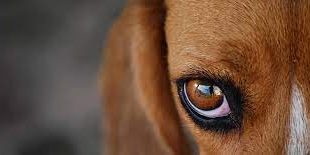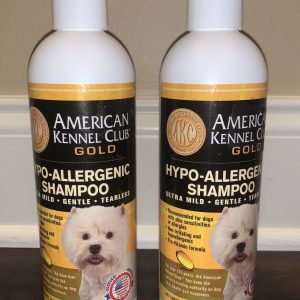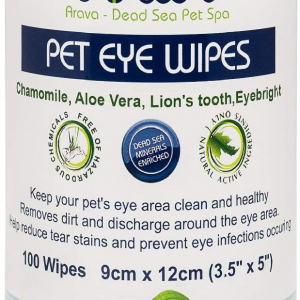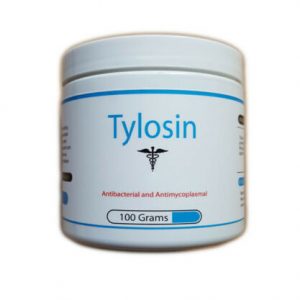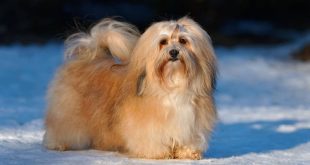Bichon Frises are known for two things: being super playful and having snowy white fur. There’s nothing more beautiful than that shiny, clean, white coat bouncing around you all day long. But of course, it’s not easy to keep your pup groomed and clean. Having an endless amount of energy means your Bichon Frise is bound to get dirty. This is easy to manage with a quick bath. The thing that requires some effort, however, is tear stains. No matter what you do, you can’t seem to get rid of those pesky streaks of red and brown, can you? Well, treating tear stains is easier than one might think. You just need a few good tips and tricks. Here are a few secrets.
-
Product on sale
 American Kennel Club Gold Whitening Dog Shampoo Pro-Vitamin Formula for Dogs with Sensitive Skin 16ozOriginal price was: $38.00.$29.00Current price is: $29.00.
American Kennel Club Gold Whitening Dog Shampoo Pro-Vitamin Formula for Dogs with Sensitive Skin 16ozOriginal price was: $38.00.$29.00Current price is: $29.00. -
Product on sale
 Arava Natural Pet Eye Wipes for Grown Dogs, Puppies and Cats- 100 Count- Free ShippingOriginal price was: $45.00.$42.00Current price is: $42.00.
Arava Natural Pet Eye Wipes for Grown Dogs, Puppies and Cats- 100 Count- Free ShippingOriginal price was: $45.00.$42.00Current price is: $42.00. -
Product on sale
 Tylosin Soluble Powder 100 gramsOriginal price was: $72.00.$65.00Current price is: $65.00.
Tylosin Soluble Powder 100 gramsOriginal price was: $72.00.$65.00Current price is: $65.00.
How to Treat Tear Stains on your Bichon Frise

Add Vinegar to your Bichon Frise’s Drinking water

Right off the bat, this seems like a weird tip, doesn’t it? What does adding white vinegar to drinking water have to do with your Bichon Frise’s tear stain? Well, here’s the idea. More often than not, your Bichon Frise’s pH levels become unbalanced due to a number of factors. This allows microorganisms like yeast to grow in the area around the eyes, leading to reddish-brown streaks. That’s where white vinegar comes in.
When you add white vinegar to your Bichon Frise’s drinking water, this helps change its pH levels ever so slightly. The altered pH levels help put a stop to the growth of yeast and other microorganisms. No growth means you won’t have to worry about your Bichon Frise’s tear stains anymore. All you need is a teaspoon of white vinegar to get the job done.
There is a catch, however. You want to keep in mind that white vinegar doesn’t taste that great. Your Bichon Frise might stop drinking water altogether if it doesn’t like the taste and this could lead to dehydration. To avoid this problem, add the white vinegar gradually, starting with small doses and working your way up. Make sure your Bichon Frise is accepting the new taste.
Antacids

Another solution for Bichon Frise tear stains is antacid tablets. You can give your Bichon Frise half a tablet daily and it’ll have the same pH-altering effect you need to get rid of tear stains. It works similarly to white vinegar, but the taste is much better so if your pup isn’t responding too well to white vinegar, there’s a good alternative.
Baking Soda
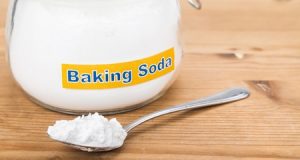
Let’s say you’re looking for a homemade remedy to get rid of your Bichon Frise’s tear stains. Well, baking soda is an excellent option. All you need is a small amount of baking soda and then just add water gradually until you have a nice, thick, paste-like consistency. Next, apply the mixture to the tear-stained areas. Let it settle and work its magic for about an hour before rinsing it off. Be gentle and make sure to stay away from your Bichon Frise’s eyes. You don’t want to cause any unnecessary irritation.
Peroxide
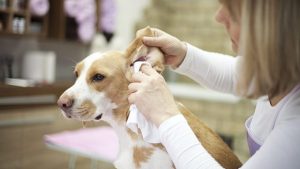
If all of these things aren’t working, there’s another option you can try: peroxide. It can even work on stains that are resistant to bleach. All you need is a few drops on a small cotton pad and wipe away your Bichon Frise’s tear stains. You might need to leave it for a few hours before rinsing it off. Just don’t forget because peroxide can be a bit irritating. You can’t let it get in your dog’s eyes because it can cause severe discomfort. This treatment method should only be used about once every week or so because even your dog’s skin gets affected by peroxide. Besides, it’s pretty effective so chances are you won’t need to reapply the peroxide any time soon.
Coconut Oil
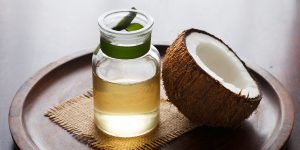
Alright, grab a pen and paper and write down this complex home remedy for tear stains. Ready? Coconut oil. That’s it. Nothing else, just pure, good old coconut oil. Surprisingly, it works wonders when it comes to Bichon Frise tear stains.
The secret lies in coconut oil’s antibacterial and antifungal properties. It has the ability to kill the infection-causing organisms that cause tear stains. Not to mention it’s great for soothing and moisturizing the skin.
Before you apply the coconut oil, first get rid of any residual moisture around your Bichon Frise’s eyes using a soft tissue. Next, apply a small amount of coconut oil to the tear-stained areas, gently massaging the oil into the fur. After that, wipe away any excess coconut oil using a soft tissue and there you go: no more tear stains. Repeat this process as often as you’d like, coconut oil is pretty safe so there’s no need to worry.
Filtered Water
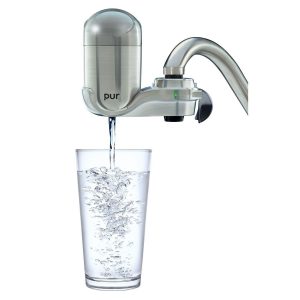
One of the things you can do to reduce your Bichon Frise’s tear stain problem is to change its drinking water. Tap water is full of minerals. So? Well, some minerals tend to accumulate in your pup’s body fluids, such as tears, leading to tear stains. Basically, the more tap water your Bichon Frise consumes, the more tear stains it’s likely to produce. Does this mean you should start buying bottled water for your pup? It’s an option, albeit an expensive one. Or you could just use purified or filtered water. By simply attaching a small filter to your kitchen sink, you’ll get purified water that’ll keep your pup healthy and stain-free.
Change your Bichon Frise’s Drinking Bowl
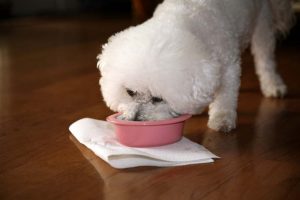
Another thing you can do to help prevent tear stains is change your Bichon Frise’s drinking bowl. If you’re currently using a plastic bowl, you might want to swap it out for a stainless-steel one. That’s because plastic bowls have tiny little barely-noticeable cracks that allow bacteria to grow and build up. Of course, the more bacteria going into your pup’s system, the more tear stains it’s liable to form. Stainless-steel bowls should help with your Bichon Frise’s tear stain problem.
Conclusion
There’s nothing cuter than a fluffy ball of cotton bouncing around your feet. You just need to keep your Bichon Frise’s coat nice and clean. With these tips and tricks, you’ll get rid of those tear stains quickly and make sure they stay away!
 Total Pooch Dog Supplements, Tear Stain Removers, De-wormers, Tylosin for Dogs and other great products.
Total Pooch Dog Supplements, Tear Stain Removers, De-wormers, Tylosin for Dogs and other great products.
